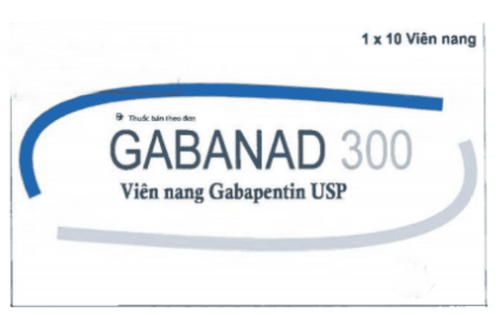This is an automatically translated article.
Gapivell is commonly prescribed for the effective treatment of partial seizures and pain of nerve origin. In order to quickly improve health problems, patients need to take Gapivell exactly as directed by their doctor about the dose and frequency of use.
1. What is Gapivell?
Gapivell belongs to the class of psychotropic drugs, used to help reverse the symptoms of partial status epilepticus in children over 12 years of age and adults. Besides, Gapivell drug is also recommended to be applied to effectively improve the pain caused by peripheral neuritis for patients over 18 years old.
Currently, Gapivell antibiotics are researched, developed and manufactured by PT pharmaceutical company. Novell Pharmaceutical Laboratories - India in the form of hard capsules. Each box contains 3 blisters x 10 tablets and each capsule contains the main active ingredient, Gabapentin, 300mg.
2. What are the uses of Gapivell?
2.1. Gapivell is commonly prescribed by doctors to treat the following conditions:
Monotherapy in the treatment of partial seizures with or without secondary generalized seizures distributed to both adults and children over 12 years of age. Adjunctive treatment for children over 3-12 years of age with partial seizures with or without secondary generalized seizures. Treatment of neuropathic pain for people 18 years of age and older. Treatment of pain caused by peripheral neuritis. 2.2. Contraindications to the use of Gapivell Gapivell should not be used in the following patients without a doctor's prescription:
Patients with a history of hypersensitivity or allergy to Gabapentin or any of the excipients other drugs contained in the drug. Gapivell is contraindicated for children under 3 years of age because the safety of the drug has not been determined for this subject. Relatively contraindicated for pregnant women or nursing mothers.
3. Dosage and how to use Gapivell
3.1. Dosage of Gapivell The following dosages of Gapivell are generally recommended by doctors:
Treatment of partial seizures with or without secondary generalization in children > 12 years of age and adults: 300 mg x 3 times/day, then increase to a maximum dose of 3600mg x 3 times/day. The interval between doses should be less than 12 hours. Adjunctive treatment of partial seizures with or without secondary generalized seizures in children > 3 years - 12 years: Dose from 25 to 35 mg/kg body weight/day, divided into 3 times/day. Treatment of pain of nerve origin in people > 18 years: Initial dose 300mg x 3 times / day, then can be increased to a maximum of 3600mg / day. For patients with renal impairment (creatinine clearance less than 80ml/min) dosage adjustment should be made when taking Gapivell. 3.2. How to take Gapivell Because it is made in the form of hard capsules, Gapivell is used orally. Patients can take Gapivell on an empty stomach or on an empty stomach, depending on the doctor's instructions.
When taking the drug, the patient should swallow the tablet whole, avoiding chewing or crushing it. This may affect the effect and action of the active ingredients in the pill.
In case you forget to take a dose of Gapivell, you need to quickly take it as soon as possible. Avoid taking it too close to your next dose or taking a double dose.
In case of overdose of Gapivell and experiencing adverse symptoms, the patient needs to stop treatment and immediately go to a medical center for diagnosis and remedy.
4. Gapivell side effects
During the use of Gapivell, patients are at risk of experiencing the following side effects:
Fatigue, headache or fever. Back pain, viral infection or abdominal pain. Digestive disorders. Vasodilation. Edema, leukopenia, memory loss or muscle pain. Weight gain, ataxia, fracture. Dizziness, depression, insomnia or dysarthria. Agitation, fussiness or anxiety in the child. Indigestion, nystagmus. Bedwetting, pancreatitis, Stevens-Johnson syndrome or skin rash. Changes in blood glucose when taking the drug to patients with diabetes or elevated liver enzymes. If any adverse effects occur during the use of Gapivell, the patient should immediately notify the doctor so that measures can be taken as soon as possible. Some symptoms will gradually disappear after stopping treatment, but there are more serious reactions if detected and treated late.
5. Notes in the process of using Gapivell
To ensure safety and early reversal of disease during treatment with Gapivell, patients should be cautious of the following recommendations:
Avoid abrupt discontinuation of the drug in patients with epilepsy as this may cause the onset of seizures. Seizures occur continuously. If a dose reduction or discontinuation is required, the patient should reduce the dose of Gapivell for a minimum of 1 week. Gapivell should be used with caution in patients with a history of psychosis, hemodialysis or renal failure. Use Gapivell with caution when operating machinery or vehicles. Pregnant women and nursing mothers should consult their doctor before deciding to take Gapivell. Gapivell should be used in these patients only when the benefits outweigh the risks. Avoid taking Gapivell with antacids to prevent the risk of an interaction reaction. In addition, the patient also needs to inform the doctor about the list of other drugs being used to have appropriate treatment. Check the quality and expiry date of Gapivell before use. Avoid medication that is past its expiration date or shows signs of watering, mildew, or discoloration. Store Gapivell at a suitable temperature (below 30 degrees Celsius), avoid areas with excessive humidity or places exposed to direct sunlight. Above is all information about Gapivell medicine, patients need to carefully read the instructions for use, consult a doctor / pharmacist before using. Note, Gapivell is a prescription drug, patients need to use the drug as prescribed by the doctor, absolutely do not self-treat at home.













